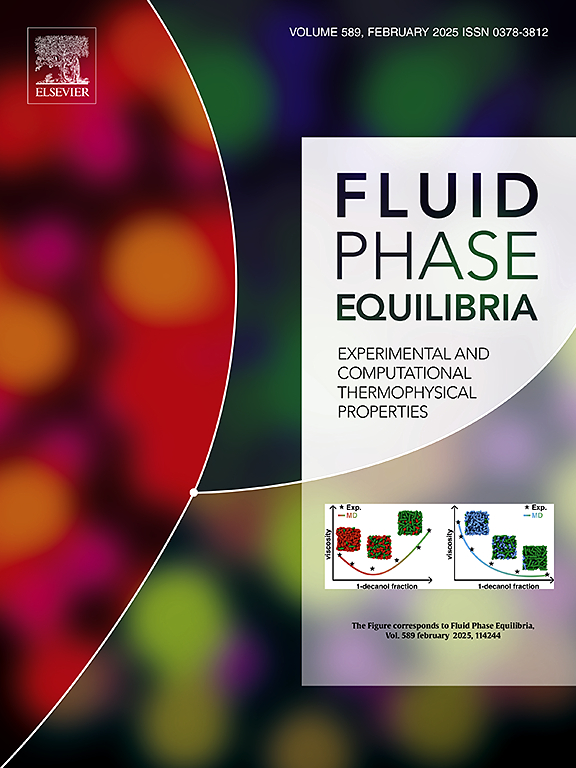Molecular dynamics simulation study on the selective extraction of 1,3 propanediol from fermentation broth using imidazolium-based hydrophobic ionic liquids
IF 2.8
3区 工程技术
Q3 CHEMISTRY, PHYSICAL
引用次数: 0
Abstract
Selective extraction of dilute 1,3 propanediol (1,3-PDO) (<20 wt %) from the fermentation broth is challenging via conventional distillation as the process becomes energy-intensive. Liquid-liquid extraction (LLE) using solvents such as ionic liquids (ILs) may significantly reduce costs. Therefore, this study explored the potential of imidazolium-based hydrophobic ILs for the selective extraction of 1,3-PDO from a fermentation broth containing 1,3-PDO, 2,3-butanediol (2,3-BDO), glycerol (Gly), and water using molecular dynamics simulations. Three ILs, having the same cation, 1‑butyl‑3‑methylimidazolium ([Bmim]+), but different anions-hexafluorophosphate ([PF₆]⁻), bis(trifluoromethylsulfonyl)imide ([NTF₂]⁻), and trifluoromethanesulfonate ([TFO]⁻)-were investigated. The local mass density profiles confirmed a well-defined biphasic system for all ILs. [Bmim][PF6] and [Bmim][TFO] showed excellent results, with 1.3-PDO distribution coefficients ranging from 2.53 to 6.71 and 4.12 to 15.40, respectively. The selectivity towards 1.3-PDO relative to water ranged from 50.6 to 192.50, while selectivity relative to glycerol (2.88–13.83) and 2,3-BDO (4.59–25.67) was also notably high. [Bmim][TFO] exhibited the strongest affinity for 1,3-PDO, with the highest binding energies and more favorable hydrogen bonds. Furthermore, diffusion coefficient analysis indicated that PDO exhibited lower diffusion rates in the extraction phase. Radial distribution function (RDF), spatial distribution function (SDF), and coordination number (CN) analyses confirmed a compact solvation shell and higher 1,3-PDO density around [Bmim][TFO]. Supported by COSMO-SAC thermodynamic model predictions, the study demonstrated that the anion plays a critical role in IL performance. Overall, the results established the extraction performance trend as [Bmim][TFO] > [Bmim][PF₆] > [Bmim][NTF₂], highlighting [Bmim][TFO] as a promising candidate for selective PDO recovery.

咪唑基疏水离子液体选择性提取发酵液中1,3丙二醇的分子动力学模拟研究
通过传统蒸馏从发酵液中选择性提取稀1,3丙二醇(1,3- pdo) (< 20wt %)是具有挑战性的,因为该过程是能源密集型的。采用离子液体等溶剂进行液液萃取(LLE)可以显著降低成本。因此,本研究通过分子动力学模拟探索了咪唑基疏水il从含有1,3- pdo、2,3-丁二醇(2,3- bdo)、甘油(Gly)和水的发酵液中选择性提取1,3- pdo的潜力。研究了三种具有相同阳离子的il - 1 -丁基- 3 -甲基咪唑([Bmim]+),但阴离子不同的il -六氟磷酸盐([PF₆]毒发展),二(三氟甲基磺酰)亚胺([NTF₂]毒发展)和三氟甲烷磺酸([TFO]毒发展)。局部质量密度分布证实了所有il都是一个定义良好的双相系统。[Bmim][PF6]和[Bmim][TFO]表现优异,其1.3-PDO分布系数分别为2.53 ~ 6.71和4.12 ~ 15.40。对1.3-PDO的选择性为50.6 ~ 192.50,对甘油(2.88 ~ 13.83)和2,3- bdo(4.59 ~ 25.67)的选择性也非常高。[Bmim][TFO]对1,3- pdo的亲和力最强,具有最高的结合能和更有利的氢键。扩散系数分析表明,PDO在萃取相中具有较低的扩散速率。径向分布函数(RDF)、空间分布函数(SDF)和配位数(CN)分析证实了[Bmim][TFO]周围存在致密的溶剂化壳和较高的1,3- pdo密度。在cosmos - sac热力学模型预测的支持下,该研究表明阴离子在IL性能中起着关键作用。总体而言,结果确定了提取性能趋势为[Bmim][TFO] >;[Bmim] [PF₆]比;[Bmim][NTF₂],突出了[Bmim][TFO]作为选择性PDO回收的有希望的候选物。
本文章由计算机程序翻译,如有差异,请以英文原文为准。
求助全文
约1分钟内获得全文
求助全文
来源期刊

Fluid Phase Equilibria
工程技术-工程:化工
CiteScore
5.30
自引率
15.40%
发文量
223
审稿时长
53 days
期刊介绍:
Fluid Phase Equilibria publishes high-quality papers dealing with experimental, theoretical, and applied research related to equilibrium and transport properties of fluids, solids, and interfaces. Subjects of interest include physical/phase and chemical equilibria; equilibrium and nonequilibrium thermophysical properties; fundamental thermodynamic relations; and stability. The systems central to the journal include pure substances and mixtures of organic and inorganic materials, including polymers, biochemicals, and surfactants with sufficient characterization of composition and purity for the results to be reproduced. Alloys are of interest only when thermodynamic studies are included, purely material studies will not be considered. In all cases, authors are expected to provide physical or chemical interpretations of the results.
Experimental research can include measurements under all conditions of temperature, pressure, and composition, including critical and supercritical. Measurements are to be associated with systems and conditions of fundamental or applied interest, and may not be only a collection of routine data, such as physical property or solubility measurements at limited pressures and temperatures close to ambient, or surfactant studies focussed strictly on micellisation or micelle structure. Papers reporting common data must be accompanied by new physical insights and/or contemporary or new theory or techniques.
 求助内容:
求助内容: 应助结果提醒方式:
应助结果提醒方式:


